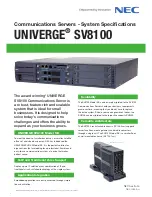
Option
Description
AGESA Version
Specifies the AGESA reference code version.
SMU Version
Specifies the SMU firmware version.
DXIO Version
Specifies the DXIO firmware version.
Memory Settings
To view the
Memory Settings
screen, power on the system, press F2, and click
System Setup Main Menu
>
System BIOS
>
Memory Settings
.
Table 14. Memory Settings details
Option
Description
System Memory Size
Specifies the memory size in the system.
System Memory Type
Specifies the type of memory installed in the system.
System Memory Speed
Specifies the system memory speed.
System Memory Voltage
Specifies the system memory voltage.
Video Memory
Specifies the amount of video memory.
System Memory Testing
Specifies whether the system memory tests are run during system boot. The
two options available are
Enabled
and
Disabled
. This option is set to
Disabled
by default.
Memory Operating Mode
Specifies the memory operating mode. The option is available and is set to
Optimizer Mode
, by default.
Current State of Memory Operating Mode
Specifies the current state of the memory operating mode.
Opportunistic Self-Refresh
Enables or disables opportunistic self-refresh feature. This option is set to
Disabled
by default.
Processor Settings
To view the
Processor Settings
screen, power on the system, press F2, and click
System Setup Main Menu
>
System BIOS
>
Processor Settings
.
Table 15. Processor Settings details
Option
Description
Logical Processor
Each processor core supports up to two logical processors. If this
option is set to
Enabled
, the BIOS displays all the logical
processors. If this option is set to
Disabled
, the BIOS displays only
one logical processor per core. This option is set to
Enabled
by
default.
Virtualization Technology
Enables or disables the virtualization technology for the processor.
This option is set to
Enabled
by default.
IOMMU Support
Enable or Disable IOMMU support. It is required to create IVRS
ACPI table. This option is set to
Enabled
by default.
L1 Stream HW Prefetcher
Enables or disables the L1 stream hardware prefetcher. This option
is set to
Enabled
by default.
L2 Stream HW Prefetcher
Enables or disables the L2 stream hardware prefetcher. This option
is set to
Enabled
by default.
MADT Core Enumeration
Specifies the MADT Core Enumeration. This option is set to
Linear
by default.
NUMA Nodes Per Socket
Specifies the number of NUMA nodes per socket. This option is set
to
1
by default.
26
Pre-operating system management applications
















































